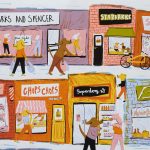
To Wander, To Lust
3 December 2013 – 11 January 2014
There is quite a big gap between urban Delhi and rural Norfolk, emotionally, environmentally, and culturally. While obviously different worlds, there are surprisingly strong cultural connections. Art 18/21 in Norwich has been blazing a trail for cultural exchange in the visual arts that acts as an example to the rest of the sector, introducing a host of Indian and UK artists to each other’s audiences for several years. This has included 2007 Fine Art graduate of Norwich University of the Arts, Alec Cumming. Cumming has seized and embraced that opportunity, using it as the inspiration for new creativity and beauty, resulting in Cumming’s first solo exhibition in India at the British Council Queen’s Gallery, Delhi.
Born in the UK in 1986, Alec Cumming was raised in East Anglia and started sketching and painting the local landscape from the age of ten, taking lessons from a local artist who taught him how to work with oil and canvas. He studied at City College Norwich where he took a Diploma in Fine Art followed by a BA (Hons) in Fine Art from Norwich School of Art and Design, graduating in 2007.
Always actively involved in Art School life, following two years as Student Union President at Norwich School of Art and Design, Cumming was a founding member of STEW artist studios in Norwich where he still works today.
Represented by Art 18/21 since early 2009, Cumming has participated in numerous group shows around the UK, hanging work alongside such personalities as John Hoyland, Maggi Hambling and Bruer Tidman. He has also held two solo shows in London. In 2013 Cumming’s work was shown for the third consecutive year at the India Art air in New Delhi. As for the future, shows in London, Singapore and New York are forthcoming.
The British Council aims to foster the exchange of cultural expression and ideas between people around the world. They encourage creative exchange and collaboration, and hope to promote a cultural inquisitiveness and intellectual curiosity about the wider world that looks beyond borders. It is this that really marks out Alec Cumming’s story; working from Neb Sarai for almost a year now, he embodies the possibilities of cultural exchange and his work is a reflection of the creative manifestation that the British Council is all about.
Cumming’s paintings are often described as abstract works by those at a loss of how else to explain them. The strange shapes and forms come together in a painting full of abstracted images that can suggest everyday objects, landscape, and figuration, among others, but this is the very thing that is to be enjoyed. It is the ambiguity and the vagueness of visual forms that allows the viewer the freedom to play with what they are seeing and enjoy the liberty of interpretation this brings.
Abstraction as a process has always been an act of give and take, of reciprocity, in both the space between the work and the viewer, the artist, and their influences. In the mid-20th century, when abstraction was at its height, just as the artists from the East were looking to modernism for new modes of expression, artists from the West were looking to the East for a spiritual essence. Considering the totality of art production in India, it is fair to say that South Asia has had a fairly brief but continuous affair with abstract art and abstraction. But the shackles of traditional labelling have been cast aside by the new generation of young artists. Like his peers working in the heart of India’s pulsating Capital, Cumming sees himself not as a painter working in the tradition of British abstraction, nor as a painter dislocated from his roots – from Norfolk in the East of England – but simply as a contemporary artist who is part of the vibrant and living Delhi art scene.
Although his painting methods have not altered with his new location, the scale of Cumming’s paintings most definitely has. A change that has been brought about by opportunity and the ability to up his scale and work on increasingly larger canvases, his works have become more-and-more physically present, not only in terms of the painted surface but also in a new preference for large vertical formats. Cummings works directly onto the raw white canvas. The preparation of his paints is a contemplative affair. In warming up for the act of painting, he mixes his colours in the heap of empty coffee cups that fill his bench which serve as a reminder of the world and life that pulsates outside his studio space.
Following the success of his first solo show in New Delhi, the Gallery at NUA is very pleased to host To Wander, To Lust – a show that is a reflection of the artist’s dedication, hard work and love of his practice. It is to be followed by his forthcoming solo show in New York.